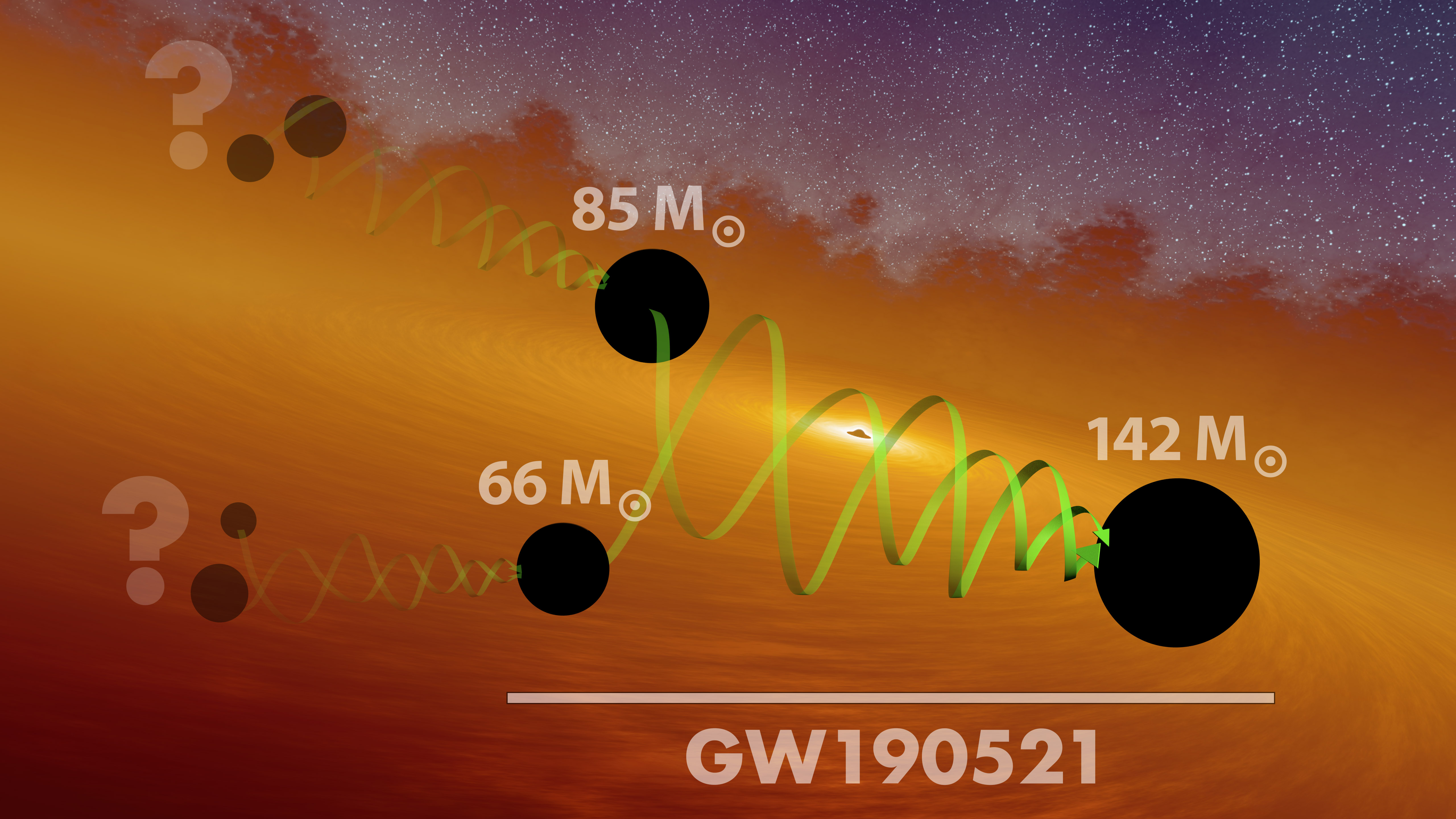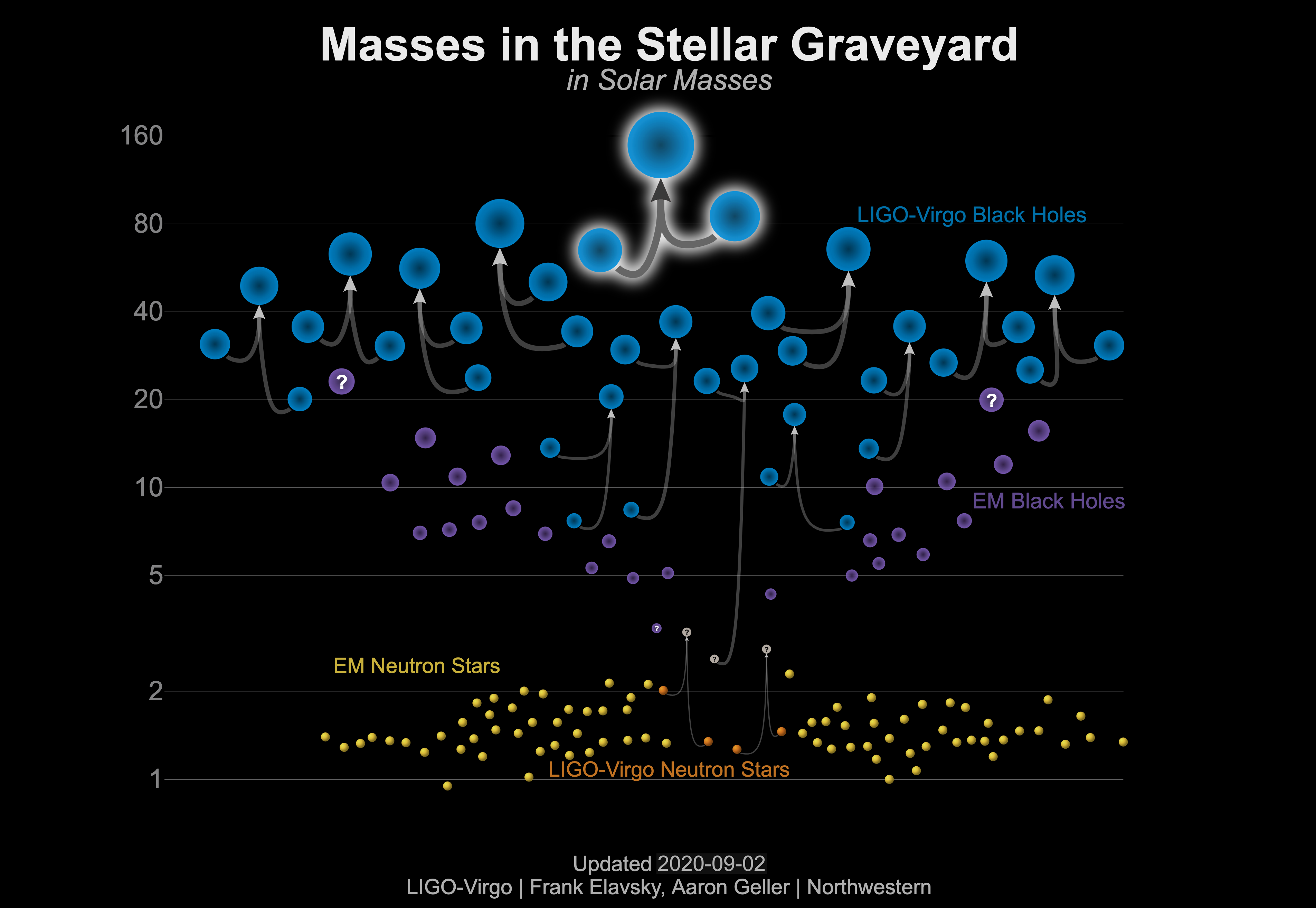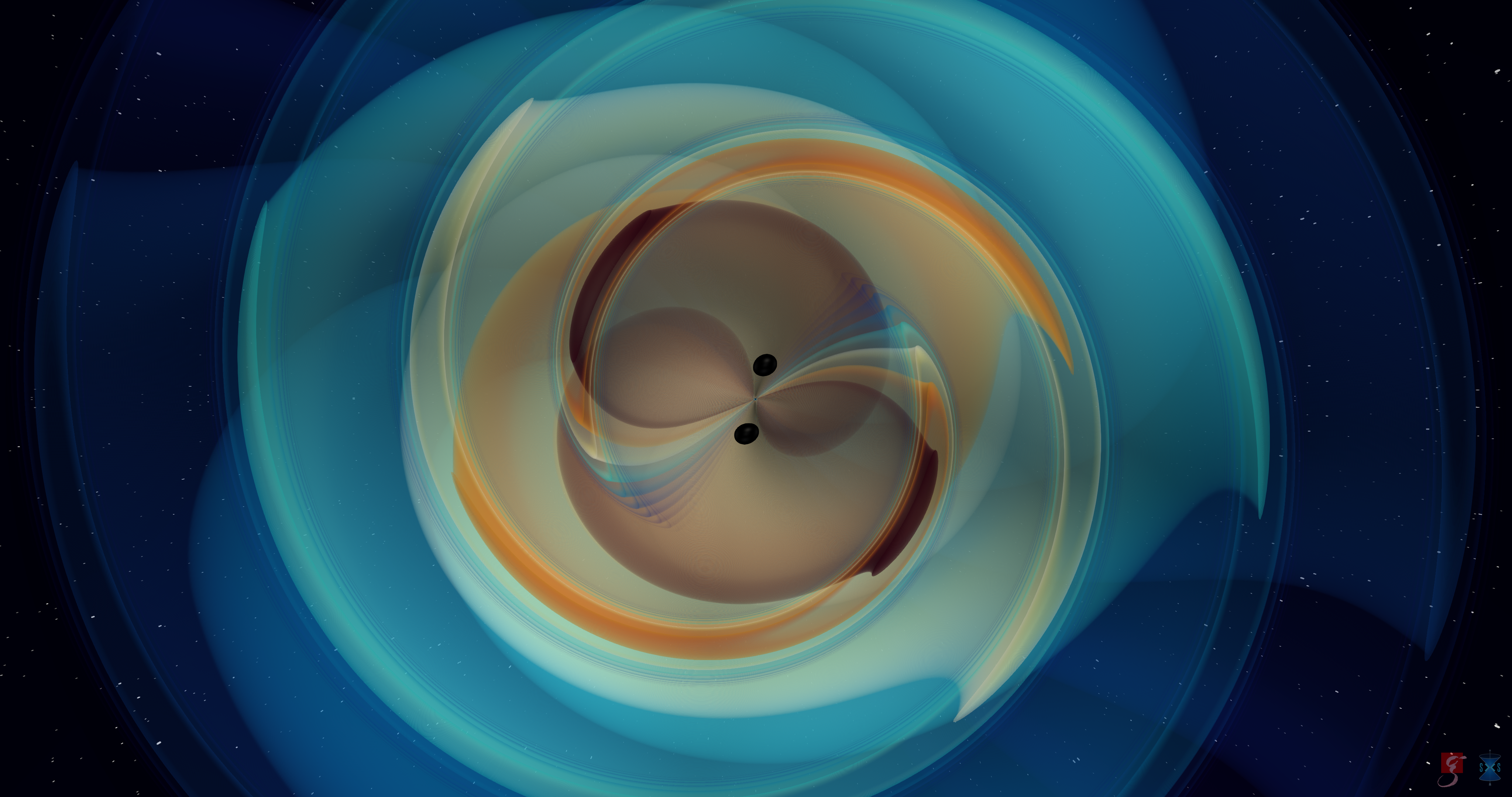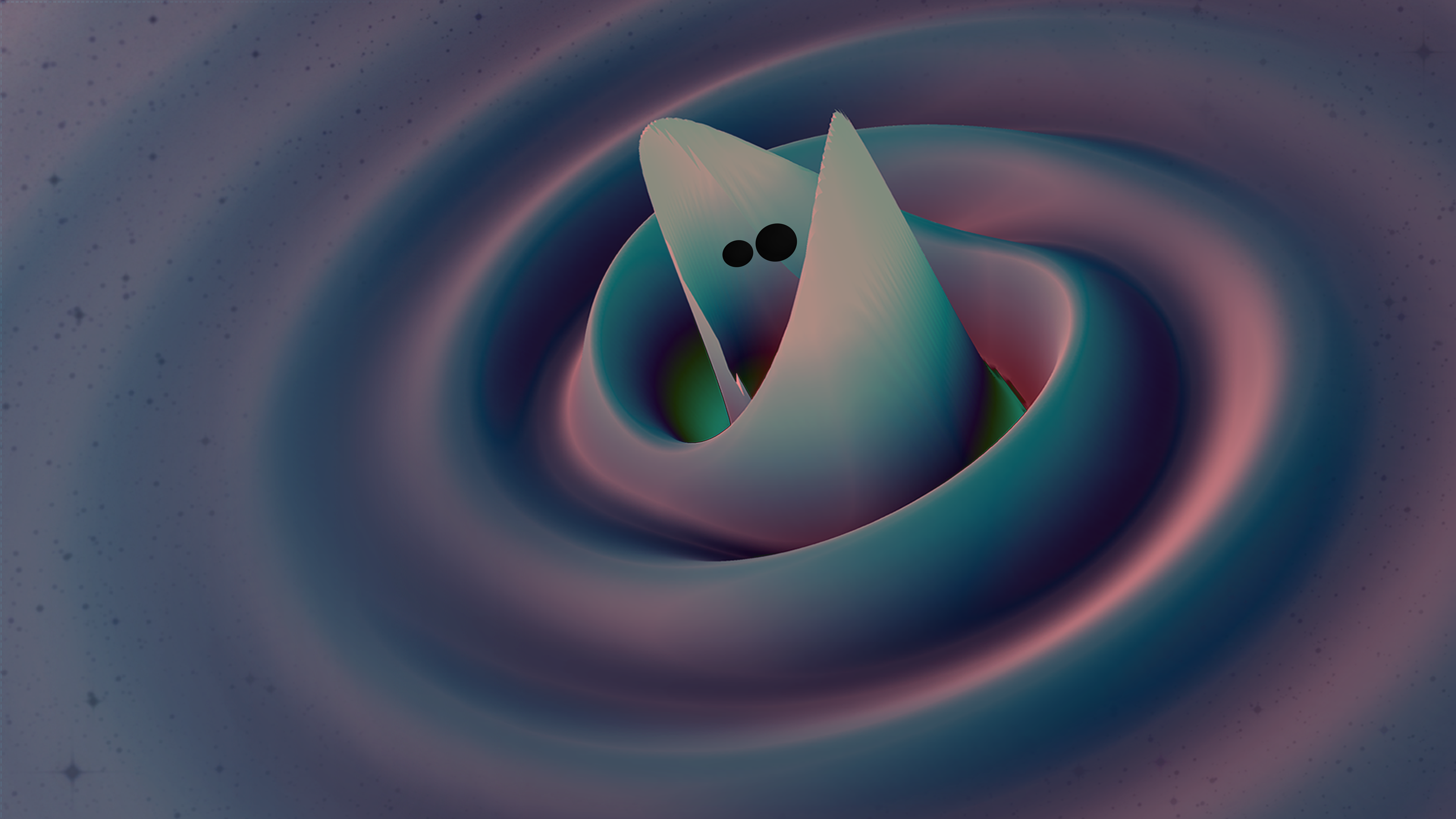Gravitational waves point scientists to elusive missing-link black hole
Astrophysicists are super excited about a new gravitational-wave "bang."
A new sound has joined the symphony of the universe as we hear it.
Since 2015, astrophysicists have been using gravitational-wave detectors to "hear" chirp-like signals and decode massive collisions that send subtle ripples across spacetime. Now, scientists have heard a new kind of sound, a fast, deep "bang" that could unlock even more cosmic secrets, according to new research from the Laser Interferometer Gravitational-wave Observatory (LIGO) and its European counterpart, Virgo.
"This is another first," Gabriela Gonzalez, a physicist at Louisiana State University and a member of the massive team behind the new research, told Space.com. "We never get tired of firsts."
After more than a year studying the strange new signal, dubbed GW190521, scientists think they know what caused it: the largest black-hole merger seen to date, resulting in a hitherto unseen intermediate-mass black hole.
Hunting gravitational waves: The LIGO laser interferometer project in photos

A thunderclap across the universe
While scientists took their time on the analysis, the signal stood out right away as something unique. Zsuzsanna Marka vividly remembers May 21, 2019, the night detectors picked up the signal. Marka is one of the few dozen astrophysicists who have connected their phones to the cosmos and receive alerts whenever gravitational-wave detectors hear a possible signal out in the universe.
"If an event happens at night, I wake up," Marka, a co-author on the new research and an astronomer at Columbia University, told Space.com. She receives the alerts so that she can check whether such events are accompanied by a burst of tiny particles called neutrinos. But as she worked that night, in the back of her mind she already knew it was a special detection.
Get the Space.com Newsletter
Breaking space news, the latest updates on rocket launches, skywatching events and more!
"I could not help but noticing the high mass," Marka said. She remembers thinking: "This is awesome. This is huge. This is really one of the incredibly high-mass events which we were hoping we would see, but it wasn't clear that, actually, those high-mass black holes exist."
Black holes come in different sizes: stellar black holes, which are 10 to 25 times the mass of our sun, according to NASA, and supermassive black holes, millions or more times larger, the behemoths that lurk at the heart of galaxies like the Milky Way. But astronomers have suspected that there might be something in between: intermediate-mass black holes that clock in at something like 100 to 1,000 times the mass of the sun, according to LIGO.

An intermediate-mass black hole can't form the way most small black holes do, from the explosions of dying stars. Stars always lose material during this process, but after a star reaches a certain size, no matter how much larger it grows, when it explodes it will result in a black hole with about 65 times the mass of our sun. Larger exploding stars simply throw away more material, ending up with black holes at that same maximum size, according to LIGO.
And until now, these theorized objects have been elusive even by the already mysterious standards of black holes. While scientists have begun to observe stellar black holes from LIGO's earlier detections and supermassive black holes from the Event Horizon Telescope's image of the object at the heart of galaxy M87, the same has not been true for intermediate-mass black holes.
This new bang represents the first observational evidence for this class of object, since calculations suggest the signal was created when an intermediate-mass black hole with 85 times the mass of our sun collided with a stellar black hole of 66 times the sun's mass.
"LIGO once again surprises us not just with the detection of black holes in sizes that are difficult to explain, but doing it using techniques that were not designed specifically for stellar mergers," Pedro Marronetti, program director for gravitational physics at the National Science Foundation, which funds the LIGO detectors, said in a statement.
"This is of tremendous importance since it showcases the instrument's ability to detect signals from completely unforeseen astrophysical events," Marronetti said. "LIGO shows that it can also observe the unexpected."

A new generation of black holes, or something more exotic?
As usual, when it comes to gravitational waves, scientists have to build their hypotheses around the scant information they can decipher from an observation.
In the case of the gravitational wave candidate GW190521, the signal was much briefer than LIGO's previous detections have been, lasting just one tenth of a second. It was also a much lower frequency than the signals produced by previous black hole mergers. Scientists could also trace the signal to a particular swath of sky.
From that information, astrophysicists can calculate the distance at which a collision occurs — about 7 billion light-years away, in this case. Scientists can also calculate the sizes of the two objects that collided, in this case 85 and 66 times the mass of our sun, and of the resulting object, about 142 times the mass of the sun. (During a collision, some mass is lost as the energy of gravitational waves.)
Because of the size limit on black holes born from dying stars, the starting masses suggest that at least the larger black hole — and perhaps the smaller as well — could itself be the result of a collision between two black holes.
"Two black holes merge, form a new black hole … then they merge again," Marka said. "This can only happen if you have a very dense environment where you have a lot of black holes."

She hopes that the collision occurred near an active galactic nucleus, a massive temperamental object at the center of a galaxy that, thanks to its powerful gravity, can anchor other objects nearby, although there's no way for scientists to be sure whether that's the story behind GW190521, given the data they have about it.
Moreover, spotting more merging intermediate-mass black holes could solve an ongoing puzzle about their larger cousins, supermassive black holes, the origins of which scientists can't explain.
"They are the million-solar-mass elephants in the room," Christopher Berry, an astrophysicist at Northwestern University and a LIGO researcher, said in a second statement. "Do they grow from stellar-mass black holes, which are born when a star collapses, or are they born via an undiscovered means? Long have we searched for an intermediate-mass black hole to bridge the gap between stellar-mass and supermassive black holes. Now, we have proof that intermediate-mass black holes do exist."
Despite scientists' excitement about the signal and the possibility they saw an intermediate-mass black hole, they can't be positive their current hypothesis is correct. Although the merger of two black holes fits the data best, astrophysicists are contemplating more exotic explanations as well.
"What if something entirely new produced these gravitational waves?" Vicky Kalogera, another LIGO specialist at Northwestern University, said in the same statement. "It's a tantalizing prospect." She added that current hypotheses for the signal's cause include the collapse of a Milky Way star or an ancient cosmic string.

After the first
Right now, the LIGO and Virgo detectors are offline, forced to close at the end of March by the coronavirus pandemic still ravaging the globe. But astrophysicists are planning to upgrade the detectors and their algorithms, then get back to listening to the universe.
Both types of upgrades will be crucial for detecting more signals like GW190521. Making the detectors themselves more sensitive will allow scientists to capture ever more distant signals, and fine-tuning the algorithms that process the data will allow scientists to identify briefer signals like this one more easily.
And seeing what appears to be the collision of two black holes that were themselves formed by mergers bodes well for the number of signals overall that are out there to observe, Gonzalez said.
"I am hoping it means that there are a lot more black holes — it might be that these are clusters of black holes, that because they are clustered together then they merge more often," she said. "I am hoping that these clusters are large and they are in lots and lots of places so we can see more black holes."
But she and her colleagues will have to see what future observations bring.
"Nature does what it does, we cannot tell nature what to do," Gonzalez said. "We take the data and make the discoveries and let theoretical astrophysicists speculate about and invent new theories about what could produce these large black holes."
The research is described in two papers published today (Sept. 2) in the journals Physical Review Letters and The Astrophysical Journal Letters.
Email Meghan Bartels at mbartels@space.com or follow her on Twitter @meghanbartels. Follow us on Twitter @Spacedotcom and on Facebook.
Join our Space Forums to keep talking space on the latest missions, night sky and more! And if you have a news tip, correction or comment, let us know at: community@space.com.

Meghan is a senior writer at Space.com and has more than five years' experience as a science journalist based in New York City. She joined Space.com in July 2018, with previous writing published in outlets including Newsweek and Audubon. Meghan earned an MA in science journalism from New York University and a BA in classics from Georgetown University, and in her free time she enjoys reading and visiting museums. Follow her on Twitter at @meghanbartels.
-
rod The report stated "From that information, astrophysicists can calculate the distance at which a collision occurs — about 7 billion light-years away, in this case. Scientists can also calculate the sizes of the two objects that collided, in this case 85 and 66 times the mass of our sun, and of the resulting object, about 142 times the mass of the sun. (During a collision, some mass is lost as the energy of gravitational waves.)"Reply
My observation. The 142 solar mass black hole has a 4.1936E+02 km Schwarzschild radius, and diameter 5.6065E-06 AU.









